Electrical Primer -
Introduction to Electricity
Last updated: 12/17/04
ęBy: John T. Blair (WA4OHZ)
 1133 Chatmoss Dr., Va. Beach, Va. 23464;
(757) 495-8229 1133 Chatmoss Dr., Va. Beach, Va. 23464;
(757) 495-8229
Before you can start to troubleshoot or fix a problem of any kind, you must have a
working knowledge of the item that is broken. This applies to anything from fixing a
washing machine to working on the electrical system of a car. The following is a primer
that will give the reader the fundamentals for working on the electrical system of a car.
I will start with an introduction to electricity and use a simple lighting circuit to
describe how to troubleshoot any electrical circuit.

The Basics 
To start, we need a simple understanding of basic electricity. Electrons are the
negatively charged particles that make up the outer shells of an atom. Electrons travel in
orbits around the atoms similar to  the planets around our sun. The only
difference is that more than 1 electron is allowed in a given orbit. In materials that are
good conductors (most metals like copper, gold, silver) the electrons in the outermost
orbit can easily be knocked out of the orbit and travel to another atom (similar to
billiard balls getting knocked around on a pool table). This movement of electrons is
called current. The more electrons that are moving, the more current flow there is.
Current is the measure of electrons flowing through a wire and is measured in Amperes
(which is symbolized by A). Its symbol in mathematical equations is I. The
best analogy for this is water flowing in a pipe, with the water molecules representing
the moving electrons. the planets around our sun. The only
difference is that more than 1 electron is allowed in a given orbit. In materials that are
good conductors (most metals like copper, gold, silver) the electrons in the outermost
orbit can easily be knocked out of the orbit and travel to another atom (similar to
billiard balls getting knocked around on a pool table). This movement of electrons is
called current. The more electrons that are moving, the more current flow there is.
Current is the measure of electrons flowing through a wire and is measured in Amperes
(which is symbolized by A). Its symbol in mathematical equations is I. The
best analogy for this is water flowing in a pipe, with the water molecules representing
the moving electrons.
Voltage is the capability to push electrons through a wire and is measured in Volts
(which is symbolized by V. Its symbol in mathematical equations is E.
Voltage can be equated to water 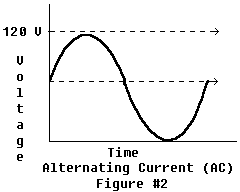 pressure, in that the pressure pushes
the water through a pipe. As the pressure increases, the amount of water flowing will
increase. The voltage in most of the newer American cars (from the late 50's onward) is
supplied by a 12 volt battery while many of the older cars, use 6 volt batteries. All
batteries and generators provide Direct Current or DC for short [the current
only flows in one direction and the voltage is constant (see figure 1)]. Household current
and current supplied by alternators is called Alternating Current, or AC for
short [the current flows out, then in, or back and forth}. Consequently, the voltage will
build up to a maximum then fall to a minimum, back to a maximum then to the minimum (see
figure 2). pressure, in that the pressure pushes
the water through a pipe. As the pressure increases, the amount of water flowing will
increase. The voltage in most of the newer American cars (from the late 50's onward) is
supplied by a 12 volt battery while many of the older cars, use 6 volt batteries. All
batteries and generators provide Direct Current or DC for short [the current
only flows in one direction and the voltage is constant (see figure 1)]. Household current
and current supplied by alternators is called Alternating Current, or AC for
short [the current flows out, then in, or back and forth}. Consequently, the voltage will
build up to a maximum then fall to a minimum, back to a maximum then to the minimum (see
figure 2).
The nice thing about a car's electrical system is that there is not enough voltage to
push the current through your body and hurt you, unlike working on the wiring in your
house which is 120 volts. At 120V there is enough voltage (push) to electrocute you.
However, be careful working on an automotive electrical system because if you were to
touch a wrench or a screwdriver from any energized or hot electrical connection to
any ground (i.e. the chassis or engine block) there is enough current to act as an arc
welder or burn up the wiring system.
Resistance is the opposition to current flow and is measured in Ohms ( ). Its symbol in mathematical equations is R.
To continue with the water analogy, any bend, kink, nozzle or restriction in a water pipe
can be considered a resistor. A resistor that can exhibit either no resistance or infinite
resistance is called a switch (like a faucet at the sink or a nozzle on the end of a
garden hose). A piece of wire or a closed switch should have no resistance (0 ohms). A
broken wire or open switch will have infinite resistance ( ). Its symbol in mathematical equations is R.
To continue with the water analogy, any bend, kink, nozzle or restriction in a water pipe
can be considered a resistor. A resistor that can exhibit either no resistance or infinite
resistance is called a switch (like a faucet at the sink or a nozzle on the end of a
garden hose). A piece of wire or a closed switch should have no resistance (0 ohms). A
broken wire or open switch will have infinite resistance ( ohms). ohms).
For a DC circuit, there is a relationship between these three entities as stated by
Ohms' law: E = I * R. For those of you that have forgotten your High School or College
algebra, it requires knowing any two if the values to calculate the other. Therefore,
three equations can be made from the one. Don't worry - This isn't a Physics class, there
will be no exam. Instead of having to memorize the three equations, here is a magic pie; 
Cover any item you want and the remaining 2 show how to calculate the desired item. For
example; if you want to know the voltage, cover the E, the remaining symbols are I and R.
This means to multiply the current (I) times the resistance (R) and the result is the
voltage (V). Covering I gives E/R, voltage divided by resistance.
A simple electrical circuit, consisting of a battery, a piece of wire connecting the
battery to an on/off switch, an on/off switch, another piece of wire connecting the switch
to a light bulb (also known as the load, and another piece of wire connecting the
light bulb back to the battery is shown in figure 3. Notice that the switch is shown in
the open position. Therefore, there is no complete circuit for the  electrons to flow through and the light bulb is not lit. This is called an open circuit.
electrons to flow through and the light bulb is not lit. This is called an open circuit.
When the switch is closed, as in figure 4, the electrons can flow from the battery
through the switch to the light bulb (thus lighting it) and back to the battery. The is
called a complete circuit.
If any of the three wires in the complete circuit were cut, it would act as another
open switch and no current would flow in the circuit. Again this would be an open circuit.
In most electrical systems, the amount of wire used to make the complete circuit can be
minimized as shown in figure 5. Remember that a wire was made of a metal. Well, so is the
chassis of the car. Instead of running the last wire (called the ground or the return
wire) from the light bulb all the way back to the battery, the chassis can act as the
return wire. To do this, one side of the battery must also be connected to the chassis.
Most modern cars have the negative side of the battery connected to the chassis, this is
called a negative ground. However, many cars, like most early (pre 1967) British
cars had the positive side of the battery connected to the chassis. This is called a 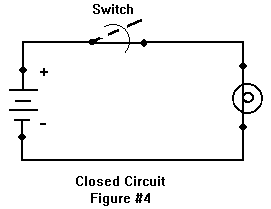 positive
ground! Be sure to check which side of the battery is connected to the chassis of your
car. If you have a positive ground car, it can be very dangerous to jump start
another car, or install a radio. You can burn up the electrical system! positive
ground! Be sure to check which side of the battery is connected to the chassis of your
car. If you have a positive ground car, it can be very dangerous to jump start
another car, or install a radio. You can burn up the electrical system!
The last item to cover in this introduction is series and parallel circuits. In a series
circuit, the items are placed one after the other; with the hot or positive side of
one item connected to the negative 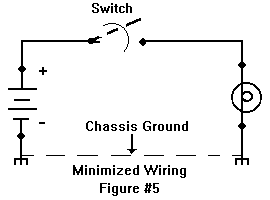 side of the next as shown in figure 6.
Batteries can be placed in series to add the voltages of each battery such as in a flash
light or a portable radio. Four 1 1/2 volt batteries are placed in series to generate 6
volts. The loads can also be placed in series such as Christmas lights. The problem with a
series circuit is that if one of the loads burns out, the entire circuit is out. side of the next as shown in figure 6.
Batteries can be placed in series to add the voltages of each battery such as in a flash
light or a portable radio. Four 1 1/2 volt batteries are placed in series to generate 6
volts. The loads can also be placed in series such as Christmas lights. The problem with a
series circuit is that if one of the loads burns out, the entire circuit is out.
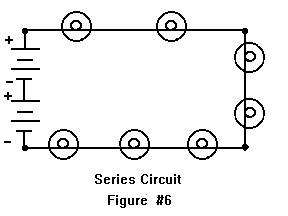 In a parallel circuit, items are placed side by side, all the positive
sides connected together and all the negative sides connected together as shown in figure
7. If batteries are placed in parallel, their voltages do not add, the current
capabilities add, the batteries can produce more current! This is used to extend the on
time of an item. For instance, if 1 battery can power a radio for 1 hour, then 4 batteries
in parallel should power the radio for about 4 hours. If the loads are placed in parallel
they will consume more current. If 1 battery can power 1 light bulb for 1 hour, it can
only power 4 light bulbs in parallel for 1/4 of an hour (15 min). The advantage to this is
that if one light bulb burns out, the remaining will still light. This is the way a car is
wired (so is a house). In a parallel circuit, items are placed side by side, all the positive
sides connected together and all the negative sides connected together as shown in figure
7. If batteries are placed in parallel, their voltages do not add, the current
capabilities add, the batteries can produce more current! This is used to extend the on
time of an item. For instance, if 1 battery can power a radio for 1 hour, then 4 batteries
in parallel should power the radio for about 4 hours. If the loads are placed in parallel
they will consume more current. If 1 battery can power 1 light bulb for 1 hour, it can
only power 4 light bulbs in parallel for 1/4 of an hour (15 min). The advantage to this is
that if one light bulb burns out, the remaining will still light. This is the way a car is
wired (so is a house).

Test equipment 
What type of tools do you need to work on an electrical system? 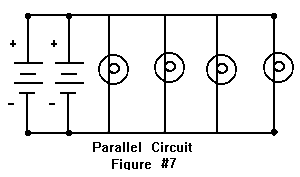 Aside from the usual wrenches and screwdrivers you will need a pair of wire cutters
(dikes), wire strippers (although a knife or dikes can be used), crimpers, a soldering
iron, and some method of testing for voltage. Most mechanics use a test light. It looks
like an ice pick with a little light bulb in the handle with a wire coming out the handle.
This is a crude voltmeter and is very inexpensive. However, I prefer to use a multimeter.
These meters can be used to check voltage (either AC or DC), current, and resistance.
Aside from the usual wrenches and screwdrivers you will need a pair of wire cutters
(dikes), wire strippers (although a knife or dikes can be used), crimpers, a soldering
iron, and some method of testing for voltage. Most mechanics use a test light. It looks
like an ice pick with a little light bulb in the handle with a wire coming out the handle.
This is a crude voltmeter and is very inexpensive. However, I prefer to use a multimeter.
These meters can be used to check voltage (either AC or DC), current, and resistance.
A voltmeter is used to tell how much voltage is present at any given point in a
circuit. (Safety tip - always start with the voltmeter
set to its highest setting to prevent damaging the voltmeter.) Notice that in the
minimized lighting circuit of figure 5, the switch is between the battery and light bulb
(the device to be powered). In this circuit, we are opening and closing the voltage
supply or the hot wire.
To use a voltmeter to test this circuit, start with the switch in the open position
(light off). Connect the voltmeter's negative lead (black lead) to ground (usually any
metal part of a car which is connected to the negative side of the battery - for a
negative ground car). Then the voltmeter's positive lead (red) can be connected to point A
or B. The volt meter will read 12 volts (the value of the battery). If the positive lead
were connected to either point C, D or E the voltmeter would read 0 volts. This is because
the switch is not letting any current flow to the light bulb.
When the switch is closed the light bulb should light. Connecting 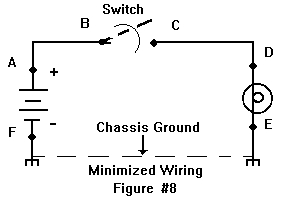 the voltmeter's positive lead to any of the points A, B, C and D, of figure 8, would read
12 volt on the voltmeter. Since a wire has practically no resistance, the voltage along a
wire can be considered a constant. Therefore, point A could be any place from the battery
to the connection on the switch (point B). Likewise, point C could be anywhere from the
other connection on the switch to the hot connection at the light bulb (point D). Point E
is said to be the ground or return path. Therefore, all the voltage (pressure) would be
dissipated across the light bulb and the voltmeter would read 0 volts (assuming a good
ground).
the voltmeter's positive lead to any of the points A, B, C and D, of figure 8, would read
12 volt on the voltmeter. Since a wire has practically no resistance, the voltage along a
wire can be considered a constant. Therefore, point A could be any place from the battery
to the connection on the switch (point B). Likewise, point C could be anywhere from the
other connection on the switch to the hot connection at the light bulb (point D). Point E
is said to be the ground or return path. Therefore, all the voltage (pressure) would be
dissipated across the light bulb and the voltmeter would read 0 volts (assuming a good
ground).

Using what you've learned 
Now that we have an understanding of the basics, lets use a multimeter to solve a problem:
Using the typical circuit of figure 8, if the switch is closed and the light doesn't
light, there are five possible causes: a bad battery, a bad switch, a bad bulb, a bad
ground, or a broken wire.

Checking the battery 
To check the battery, the switch should be open (turn off the light) to isolate the
battery. The negative lead of the voltmeter is connected to the negative battery terminal
and the positive lead from the voltmeter is connected to the positive battery terminal.
The battery is marked 12V and is so indicated in figure 8. The voltmeter should read 12V.
(Note: a voltmeter draws very little current, therefore, a bad battery could actually
indicate 12V on a voltmeter.) Next, close the switch (turning on the light). If the
battery is bad, the voltmeter will indicate less than 12 volts. The lower the voltage, the
worse the battery is. If the battery is bad, replace it and try the circuit again. The
light should light if the new battery is good (not always the case) and there is no other
problem in the circuit.

Checking the switch 
To check the switch, the positive lead from the voltmeter should be connected to the
battery side or hot wire of the switch (point B). The negative voltmeter lead is still
connected to ground. The voltmeter should read 12V. (If not, and the battery tested good
above, the supply wire is broken. More on this later.) Connect the positive lead from the
voltmeter to point C. With the switch in the open (off) position the voltmeter will read
0V. When the switch is closed, the voltmeter should read 12V. If not, the switch is bad.
What kind of bad? Does anybody really care? I do. If the voltmeter always reads 12V then
the switch is shorted out. In other words, the switch is always closed and can't open. If
the voltmeter always reads 0V then the switch is always opened, or the switch never
closes.
If the switch tests bad, replace it, and try it again.
The switch can also be tested using the ohmmeter portion of the multimeter. This is
also called a continuity test. Switch the meter  from the voltage scales to the resistance scale Rx0. (Note: on some multimeters the red
lead will have to be moved from the voltage (V) socket to the ohm ( W ) socket.) All the
wires to the switch must be disconnected to prevent damaging the ohmmeter. With the
switch out of the circuit, attach one of the leads (it doesn't matter which one) to one of
the connections on the switch and other meter lead to the other connection on the switch
(points B & C). When the switch is in the OFF position, the meter will read infinite
resistance (the needle will not move). When the switch is placed in the ON
position, there will be a closed circuit or a short, and since we already said that
the wire has almost no resistance, the meter will read 0 ohms (the needle will move to the
other end of the scale). If both of these conditions are met, the switch is good.
Otherwise, the switch is bad. Earlier I said there wouldn't be a test. Fooled ya! If the
ohmmeter always read infinite resistance, what is wrong with the switch? What if it always
reads 0 ohms?
from the voltage scales to the resistance scale Rx0. (Note: on some multimeters the red
lead will have to be moved from the voltage (V) socket to the ohm ( W ) socket.) All the
wires to the switch must be disconnected to prevent damaging the ohmmeter. With the
switch out of the circuit, attach one of the leads (it doesn't matter which one) to one of
the connections on the switch and other meter lead to the other connection on the switch
(points B & C). When the switch is in the OFF position, the meter will read infinite
resistance (the needle will not move). When the switch is placed in the ON
position, there will be a closed circuit or a short, and since we already said that
the wire has almost no resistance, the meter will read 0 ohms (the needle will move to the
other end of the scale). If both of these conditions are met, the switch is good.
Otherwise, the switch is bad. Earlier I said there wouldn't be a test. Fooled ya! If the
ohmmeter always read infinite resistance, what is wrong with the switch? What if it always
reads 0 ohms?

Checking the light bulb 
To test the bulb, the ohmmeter function of the multimeter must be used. Set the multimeter
to Rx0 scale. (Warning: When using the ohmmeter there
cannot be any voltage present, the battery must be disconnected, or the meter can
be damaged. I know I'm repeating myself but this is very important.) The easiest way to do
that is to remove the light bulb from the socket. If this is not practical, disconnect the
battery. The ohmmeter leads can be connected to the side of the light bulb and to the
connection at the bottom. If the element in the bulb is good it should read less than 30
ohms. If it is burned out, it will read infinite resistance.
If the light bulb tests bad, replace it and try the circuit again.

Checking the ground 
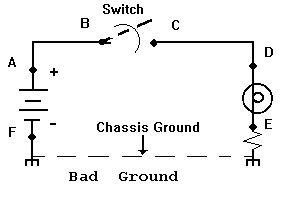 The easiest way to test for a bad ground is to attach a wire to a known good
ground and to the ground side of the circuit in question. In our simple example that would
mean connecting another wire between the negative side of the battery (point F) and the
ground side of the light bulb (point E). Now turn on the switch, does the light light? If
so, then one of the ground connections was bad or the ground wire was broken. The easiest way to test for a bad ground is to attach a wire to a known good
ground and to the ground side of the circuit in question. In our simple example that would
mean connecting another wire between the negative side of the battery (point F) and the
ground side of the light bulb (point E). Now turn on the switch, does the light light? If
so, then one of the ground connections was bad or the ground wire was broken.
The ground can be checked with the voltmeter. Connect the voltmeter's red (positive)
lead to point E. If the meter doesn't read 0V, it means that the ground is bad. There
appears to be something else (a resistor) in the circuit (as shown in figure 8). A
resistor is an electronic component that resists current flow. While there is an actual
component for this, any electrical device such as a motor, a light, can electrically be
considered a resistor or a load.
To test the ground with the ohmmeter, break the circuit by ensuring the switch is in
the off position. The safest and smartest thing is to disconnect the battery. Connect the
ground (black) lead of the ohmmeter to a known good ground. Then connect the positive
(red) lead to the ground side of the light (point E). If the meter doesn't read 0 ohms,
then the ground is bad.
A bad ground is a very common occurrence in a car's electrical system. The only problem
is finding out where the ground is. Usually there is a short black wire coming from the
load (the light bulb in our circuit) and bolting to either the chassis or some metal part
(like a fender well or the firewall) that is mechanically connected (bolted) to the
chassis. To fix a ground connection on a car, remove the bolt attaching it to the metal.
Clean the connector on the end of the wire and the metal where it attaches with a piece of
sandpaper. Both the connector and the metal should be shinny. Reattach the connector to
the metal and check the circuit again.
One other note about bad grounds. For lighting circuits, a poor ground will usually let
the light bulb light although dimly. In other automotive circuits, they can produce all
kinds of erratic results, such as when the right turn signal is turned on, the radio quits
playing! Here the two items, the right turn signal bulb and the radio share the same
ground. Due to the fact that current will take the least resistive path to ground (back to
the battery) the current flows to the light bulb and not the radio.

Checking the wire 
The ohmmeter is also used to check for a broken wire. Suppose the wire from point C to
point D is thought to be broken. To test it, place one lead at point C and the other lead
to point D. The meter should read 0 ohms. If not, the wire is broken and needs to be
replaced.

In a Car 
In a car the test just described can be more difficult as the wire might start at one
headlight, run across the engine compartment, back along the fender well, and penetrate
the firewall. The lead on the meter will not reach that far. There are two options. Use a
long piece of wire to attach the remote end of the wire to the meter lead. This wire can
be any kind of wire, such as hookup wire, speaker wire, or an extension cord. One of the
ohmmeter leads would be attached to this long wire, and the other lead attached to the
near end of the wire. The second option is to touch the remote end of the wire to a metal
part that is attached to the chassis and let the chassis act as the long wire. A short
piece of wire may be needed to reach between the chassis and the wire under question. If
the wire is intact, we have a short between the two ohmmeter leads. Therefore, the meter
should read very close to 0 ohms.
The heart of all this is the battery and the veins and arteries of a car is the wiring
harness. The wiring harness can be though of as 3 separate harness', typically a
front harness, a rear harness, and a middle harness that connects the rear harness to the
main electrical supply or fuse block. Cars that have more auxiliary equipment such as
power windows and seats will have additional harness to support the additional equipment.
To protect the wires from the heat, grease, and from getting nicked, the bundles of
wires are usually wrapped with something. There are three usual coverings for the wiring
harness depending on the type and age of the car.
- The first is like black electrical tape. Older cars used a cloth tape while the newer
cars use a plastic tape.
- The second covering is a cotton weave called loom (use in older cars - especially
British). This is actually spun or woven around the wires in the harness.
- The third covering, which is used in the more modern cars, is the black, ribbed, split
plastic tubing sometimes called conduit. It comes in various diameters. The more wires in
a given bundle, the larger the diameter of the loom must be to cover the wires.
To follow a wire from one point in the car to another, the covering may have to be
removed. The tape covering can be carefully cut with a knife, a pair of dikes or simply
unwound. The plastic conduit or loom pulls off. Find the end of the conduit and look for
the slit. Pull on the conduit from the side opposite to the silt and perpendicular to the
wires. This conduit can be reused unless it is broken, or very dirty. The conduit is
readily available at the auto parts stores.
When working with the electrical system on an older car, be sure to check the
insulation. This is the rubber covering, on a wire itself. The insulation can be come
brittle with age and especially from the heat of the engine. Look for tiny cracks. In some
cases it can be so bad that the insulation actually falls off of the wire. If the wire has
cracks in the insulation, it should be replaced. Otherwise, the wire can short out to
another wire in the harness or some piece of metal in the car.

Anatomy of wire 
The diameter of the wire is an indication of the amount of current it
carries. The larger the wire, the more current it can carry. As an example of this, look
at most of the wires, they are relatively small. Now look at the main wires coming from
the battery. These wires are quite large as they must supply a lot of current when trying
to start the engine.
The thickness of the insulation is an indication of the voltage in the
wire. Again, most of the wires in a car have very thin rubber insulation on them. However,
if you look at a spark plug wire, you will see that the insulation is quite thick with
respect to the size of the wire. This is because most of the wires, in a car, are for 12
volts, but the spark plug wires carry 20,000 volts or more. To size a wire, I suggest
getting an inexpensive wire stripper. Most of these have different size holes in them for
the different gauges of wire. Cut off about 1/2" of the insulation (to reveal the
bare wire) and find the hole that the wire fits in. That is the gauge wire needed.
Also notice that most of the wire in a car is stranded. This means that a wire
is composed of many smaller wires. (There is also a solid wire.)
Automobiles use stranded wire because stranded wire bends and withstands flexing much
better than the solid wire. As an example of this, take a lamp cord - be sure the lamp has
been unplugged from its socket. Try to wiggle it, bend it back an forth. It is easily
worked with no adverse results. Now take a coat hanger and cut off the top hook.
Straighten it out. Now try to wiggle or bend it. Once bent, it holds that bend. If you
bend it back and forth several times, the wire will break. The solid wire can't withstand
the constant working. To replace a piece of wire in a car, be sure to use the correct size
(gauge) of wire and preferably the same color of insulation.

Graduation 
There you have it. A short course in basic electricity and troubleshooting a simple
electrical light circuit. The main difference between the drawing and a car's electrical
system is that in the car, there are more wires. Hopefully, this will helped you get a
better understanding of basic electrical troubleshooting and how to use a multimeter.
 Enjoy your Bricklin Enjoy your Bricklin
 John Blair John Blair
Return to the Index of Tech. articles
|
